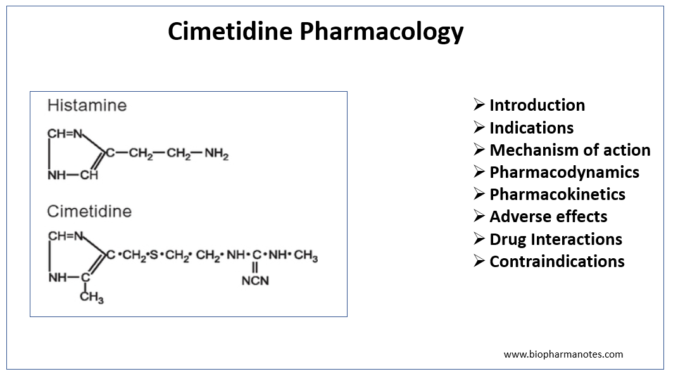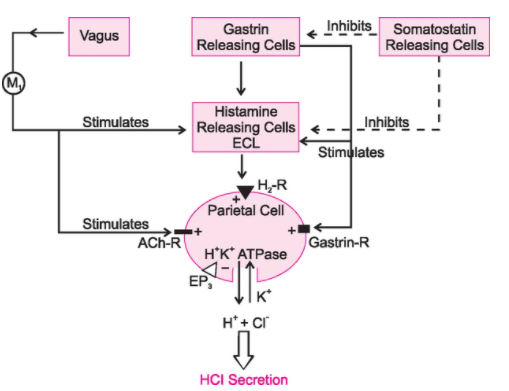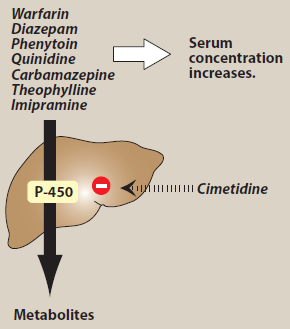
- Cimetidine is histamine H2 receptor antagonist. H2 receptor antagonist are first class of drug used for treating peptic ulcer, but their use nowadays is surpassed by PPI (proton pump inhibitors).
- Other H2 receptor antagonist available in market are ranitidine, roxatidine and famotidine.
- It is first H2 receptor antagonist to be introduced clinically. Cimetidine was developed in 1971 and FDA approved its use in 1979. It is available as prescription as well as over the counter medication.
Indications of Cimetidine
- Used for treatment and management of GERD (Gastric Oesophagul Reflux Disease).
- Used in treatment of peptic ulcer, heart burn and acid indigestion.
- In acute stress ulcer.
Mechanism of action of Cimetidine

Figure- Mechanism involved in regulation of gastric acid secretion by parietal cells (ECL- Enterochromaffin cells, R- Receptor, EP-R- PG receptor for PGE2) Source- Pharmacology and Pharmacotherapeutics, 24th edition.
- To understand mechanism of action of cimetidine, we should first understand mechanism of gastric acid secretion. The primary stimuli for gastric acid secretion include
- gastrin, released from antral G cells
- histamine released from oxyntic enterochromaffin-like cells
- acetylcholine released from antral and oxyntic neurons secondary to parasympathetic (vagal) stimulation.
- Other stimuli for gastric secretion include ghrelin and motilin.
- Histamine stimulates parietal cells by acting on H2 receptors. This is mediated by adenylate cyclase activation and generation of cyclic AMP (cAMP).
- Cimetidine is structurally similar to histamine. Hence, it competes with histamine for H2 receptor and cause competitive blockade of parietal cell H2 receptors.
- Binding of histamine to H2 receptors is one of the factors responsible for promoting gastric acid secretion. Hence, blockade of H2 receptors helps to reduce secretion of gastric acid.
Pharmacodynamics of Cimetidine
- It inhibits gastric acid secretion stimulated by histamine, caffeine and acetylcholine by around 80-90%. Cimetidine also helps to inhibit basal and meal stimulated acid secretion. It has effect both on volume and acid content of gastric juice. It can cause 20 % reduction in acid production within an hour of oral administration.
- Cimetidine has less effect on pepsin secretion. It doesn’t have any direct effect on gastric or esophageal motility and gastric emptying at all.
Pharmacokinetics
- It is adequately absorbed after oral administration. Its absorption is not affected by food and undergoes first pass metabolism. It can also be administered though oral or IV route when it cannot be administered though oral or nasogastric route.
- It can cross placental barrier and is also secreted in milk. Its brain penetration capacity is poor. Around 2/3rd is excreted unchanged in urine within 24 hours. Its half-life is around 2-3 hours. Dosage adjustment may be needed in renal patients.
Adverse effects
- As histamine H2 receptors are widely distributed in other parts of body including brain, heart and bone marrow, their blockade may lead to range of adverse effects. Cimetidine may cause drowsiness, mental confusion and hallucination. Other side effects include rashes, diarrhea, headache, muscular pain, fatigue and bradycardia.
- Its long-term use in high dose can cause reduced sperm count, gynecomastia and impotence in man and galactorrhea in women. Long -term use my also lead to hepatic dysfunction and blood dyscrasias rarely.
Drug Interactions

Figure- Cimetidine drug interaction (Source- Lippincott’s Illustrated Reviews)
- It inhibits CYP3A4 and CYPIA2 enzymes and hence reduces clearance of drugs like warfarin, diazepam, phenytoin and theophylline. It increases hepatotoxic effect of paracetamol and isoniazid. Cimetidine may reduce effectiveness of drugs like ketoconazole which require acidic environment for absorption.
- When coadministered with sucralfate or large doses of antacid, its bioavailability is hampered. So, these drugs should not be administered within 2 hours of cimetidine or any other H2 receptor antagonist.
Contraindications
- Contraindicated in patients showing hypersensitivity to cimetidine or other H2 receptor antagonists.
- It is a pregnancy category B drug. Category B drug means no fetal risk is shown in animal studies and no adequate and well controlled studies are conducted in pregnant females.
- Low dose should be used in elder patients to minimize CNS effects.
References
- Cimetidine – StatPearls – NCBI Bookshelf (nih.gov)
- Lippincott Illustrated Reviews Pharmacology, 6th edition.
- Pharmacology and pharmacotherapeutics. 24th edition.
- Goodman and Gillman Manual of Pharmacology and Therapeutics.
- Essentials of Medical Pharmacology. 7th edition.